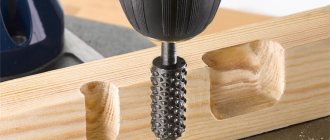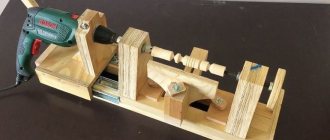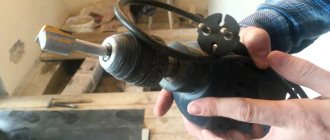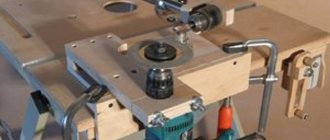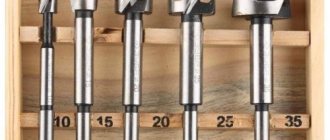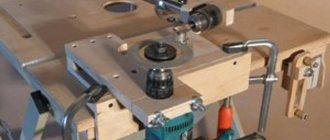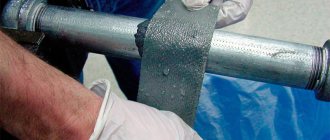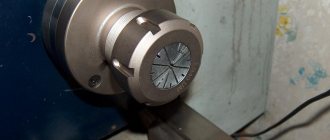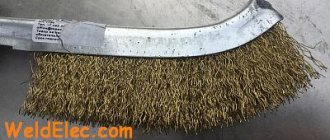The functionality of electrical appliances can be increased by connecting devices and various additional accessories. Thus, a wood cutter for a drill allows you to work with wood and cut shaped notches in timber. They achieve a high-quality level in roughing or finishing of blades by installing working attachments with an actuator.
Wood cutter for drill
Manufacturers have produced various types of cutting elements, but they need to be selected correctly; they must be suitable for working with a specific drill.
general information
The drill cutter is one of the replaceable elements. Each part in the assembly performs an important function. The motor of the electrical appliance transmits the rotation speed to the shaft, and the nozzle with accessories will rotate with it.
Milling cutter
Only the cutter processes a given area. The final result depends on the correct choice of which, combination of parameters, compliance with conditions.
Features of working with a drill and cutter
Milling involves processing the material with a cutter installed in a stationary housing of the power device. In this case, it is assumed that the speed and depth of penetration into the processed material are regulated on the tool. But the array on which the action is performed must move. Such machines are called milling machines.
You can use a drill as a router only in certain cases. The reason is the special precision of work and the high force on the drive. Drill cutters are specially designed taking into account the power and methods of regulating the device. The shape of the drill and its center of gravity are of great importance for the work.
Features of using a cutter for a drill:
- a change in the load vector can damage the gearbox if additional pressure is applied to the workpiece;
- the motor overheats, frequent rest is required;
- the load on the plastic body can lead to armature misalignment and deformation;
- fastening in a chuck with a horizontal axis of operation is unreliable.
All this suggests that the drill as a milling cutter operates in an unusual position and with unusual directions of resistance forces. You need to work slowly and carefully with the milling attachment for a drill.
How the cutting part works
Actuating mechanism
The actuator consists of 2 elements:
- shank (1) – it is clamped by a cartridge to transmit torque;
- working sphere (2) – there are sharpened blades on the sides of the head.
The configuration of the cutting edge provides different capabilities to this knife. The quality and type of sharpening are used to perform tasks of varying complexity. An additional element - a support bearing (3) - can simplify milling with a drill or expand these functions. For example, process a workpiece according to a template. If the system is dismountable, the cutter with its constituent parts regulate the work processes in the desired direction using:
- locking couplings;
- calibration bushings;
- washers;
- screws
The shank or base of the cutter comes in different lengths and diameters. These parameters are taken into account when choosing.
The chuck must hold the part tenaciously and be long enough to perform specific operations. The technical characteristics and purpose of the blade determine how much work can be done with it. It is sharpened manually and using high-precision equipment if there are no backlashes in the structural elements. In addition to sharpening, the alloy from which the item is made is also important. The hardness level of the steel must correspond to the structure being processed, in this case wood.
The standard set of cutters includes elements of different parameters and categories in the form:
- mounted, when the landing part with a diameter of 32 mm can only be installed in stationary milling equipment;
- end with a shank from 8 to 12 mm. in diameter, they are mounted on the machine shaft and on the drill.
This assembly replaces a professional milling cutter when processing:
- natural wood;
- plywood;
- chipboard;
- MDF.
When the cutting tool is going to process plywood, a knife with a high level of wear resistance is inserted. Let's say that a jigsaw with its cutting plates contains a strong alloy and is not sharpened.
Application at work
This attachment will turn your power tool into an efficient woodworking machine:
- cutting grooves of complex shape;
- grinding corners and edges;
- processing complex elements.
And this is not a complete list of possibilities that open up with a working attachment for a drill. A correctly selected part for a specific task will help you complete not only the rough work, but also the finishing touches.
What do they pay attention to?
If you use a drill for milling wood, take into account a number of features:
- The operation of bearings on a shaft with the calculation of axial longitudinal load. In some types of mechanisms, a lateral force is applied, which affects the rapid wear of parts.
- Speed of revolutions.
- Cooling methods.
- Engine power.
- Handle placement.
- Cartridge quality.
Electric drill cutters
The electrical device must be equipped with a function that regulates speed with a large reserve of power - this means that cutters for an electric drill can be installed on it.
If there is incompatibility in the mechanism of devices, negative consequences are possible:
- the tool will overheat;
- the gearbox will fail;
- in the process, a distortion of the workpiece is formed;
- the shank will pop out due to an unreliable cartridge.
There are unwritten rules for milling:
- actions are performed slowly, accurately and accurately;
- check all connections, electrical wiring, fixation;
- Allow the drill to cool periodically.
When large volumes of work are to be done, a carbide nozzle is needed. Only after the equipment is securely fixed in the chuck do they begin to mill.
Choose a knife according to the following criteria:
- size - the parameter affects the assigned technological task;
- shape, configuration, location of the blades;
- sharpening angle;
- manufacturing materials - the performance of various operations and service life depend on the steel;
- purpose - if the milling drill is durable, it is used not only for wood drilling, but also for harder materials.
When buying any product, they visually evaluate it and look at the manufacturer’s company. The reputation of the enterprise will reveal the pros and cons of production. You need to do the same with the equipment. If the buyer is not rich enough to afford a cheap thing, the cutter should be of good quality and expensive.
Purpose of different types
There are many tools available to process wood. Various machines, jigsaws, grinding devices - this is due to different specifications of materials and the complexity of the procedure. Among the tips for drills, the following types are distinguished.
- Moulding – it is used for rounding corners and grinding them.
- V-shaped ones are used for making cuts of the same name and creating a groove on a wooden panel. Can also be used to create an inscription or pattern. In addition, the cutter performs edge processing.
- Disc ones are indispensable for creating grooves, grooves and recesses of any depth.
- Folded ones are similar to disk ones, but provide greater freedom of action. They are often used to cut a groove for glass.
- Fillet - to create semicircular grooves at the ends of the workpiece, they are equipped with a special support bearing. Used in the manufacture of furniture slats.
- Spike - a nozzle equipped with a cutting edge, made in the form of a reverse spike. Used for making dovetail grooves. Great for creating hidden connections.
Wood cutter, tongue-and-groove
- Cylindrical - with the help of such a nozzle the flat surface of wooden parts is processed. During manufacturing, the part is equipped with straight or helical blades.
Of course, such attachments are not always able to replace a full-fledged machine or the same jigsaw, but they are quite capable of satisfying a one-time need.
Design Features
The cutting device is based on the teeth around its body and the manufacturing technology of the structure itself:
- solid - made of one metal composition;
- combined - with knives made of one hard alloy and a body made of another metal;
- welded, when the shank is connected to the blades by welding;
- soldered - the assembly is fixed by soldering.
The blades can be pointed with a front and back flat surface. The disadvantage of such items is that they are sharpened; they shrink in size, so they are not suitable for reusable use. Unlike backed bits, which can be resharpened. On the front side they are flat, and on the back they are twisted like an Archimedean spiral. Such a profile is obtained by uniform movements - translational and rotational. The backing procedure is performed with cams, which creates a stable back angle along the entire length. A similar design is created for cutters:
- shaped;
- worm;
- modular.
Cylindrical peeling knife
The mounted cylindrical peeling knife has separation grooves for chips.
They are directed in one direction, and the backed tooth is directed in the opposite direction. Blades placed in different directions allow high-quality processing of side walls. They are pressed into the body, where the radial corrugations move. After sharpening, the dimensions of the actuator do not change.
Why do you need a drill on a magnetic bed?
When developing a drill on a magnetic bed, we were guided by the problem of creating holes in multi-ton metal structures that cannot be moved. Such trusses, like a large magnet, attract a pair with an opposite charge. Creating a charged frame for a drill solved the problem of securing a tool for drilling holes with high precision.
Drilling large cross-section holes in metal is carried out using different attachments, including using a milling cutter for a drill on a magnetic bed. Typically, this attachment is used in the form of a hollow crown. Drilling with a magnetic drill according to the markings is guaranteed to be accurate. As long as voltage is applied to the frame, the drill is held on the plane with a force of several tons per square centimeter. After turning off the current, the installation is easily moved to a new location; its weight does not exceed 25 kg.
A hole saw can be used to drill a hole in a structure up to 130 mm in diameter.
Basic actions and their order
Wood is a soft raw material. Different types of cutting tools have been developed for its processing. When choosing equipment you need to consider:
- The wood cutting knife should not be used for grinding or cutting metal structures.
- The drill for metals is made of strong high-alloy compounds that cannot negatively affect the operation with chipboard. There will be no overheating of the motor and gearbox. The end blade has this design; it is used to cut sheet material, and small-sized groove milling is performed. Although such models are endowed with a small number of feathers.
Groove cutter with different geometries, convenient for creating long grooves. And shaped cutters are used only for tortuous, complex design configurations.
Edge knife
The edge knife itself speaks about its purpose; it is good for sanding the sides. A bearing is installed at the end of such blades; it regulates the direction and prevents it from moving away from the formation of the edge. Finishing is performed on both straight and shaped edges.
Repairs to wooden buildings are not complete without sealing old holes and cutting out new ones.
Actuator of different designs
This requires a drill, and to perform several tasks you will need a whole set.
Where each tool has its own dimensions in diameter and length. They have the peculiarity of changing proportionally. When one value increases or decreases, another indicator changes in the same direction. There are no thin and long elements; they will simply break under a slight load. For example, at 12 mm. diameter, the length will be a drill bit for a drill of 50 mm., There are also 60 mm. These devices are also different in appearance:
- spiral;
- screw;
- feathers;
- ring;
- countersinks;
- flexible.
Through space can be created, different in geometric shape:
- cylindrical;
- conical;
- stepped;
- square.
The mechanism for wood processing, unlike metal processing, has a conical end; it is used to mark the drilling location.
Processing plastic with a drill and cutter
A special feature of plastic processing is its viscosity. When exposed to a cutter at high speed, the plastic first begins to wrap around the cutter and then liquefies. Therefore, the selection of drills and the processing speed of each polymer causes certain difficulties. A plastic cutter for a drill is selected depending on the type of material:
- thermoplastics;
- thermosets.
From the name it is clear that thermoplastics become fluid under the influence of temperature, the chips of such materials are draining, with melted edges. Thermoset plastics are not subject to softening when heated. Often this material is produced with reinforcement. Based on the properties of the polymer, cutters and processing modes are selected.
Thermoset plastics are processed with multi-flute cutters, while maintaining smooth processing. The depth of one cut should not exceed 2.5 mm. Otherwise, the surface being treated can be destroyed. Taking into account the artificiality of the material, it is necessary to organize the suction of microparticles so that dust does not enter the respiratory system of the worker.
Soft material must be cut with two-flute cutters at low speed so that the material does not “drip.” For sheet plastic, it is better to use compression cutters for edge processing.
How to prepare a drill for milling
Electric drill
It may not be possible to open a full-fledged carpentry business with an electric drill, but in a home workshop, various milling procedures are often simply necessary.
Reconstruction begins from the place where the electric motor will be mounted.
If you don’t have an old table, you can put it together from available materials - boards, plywood. Bars are suitable for support legs. A recess is made on the countertop for installing the device with guides. You will need to cut a semicircular groove with a saw and drill through the circles to attach the support sheet.
After building the table you will need:
- electrical appliance;
- small cutter for testing;
- cartridge;
- chipboard sheets.
The drill is secured with clamps to a chipboard stand. The cutter is installed on the shaft. The elevator will be the carriage of the power tool with the main body. The stand and the limiting platform are connected at a right angle. The knife should extend beyond the base.
Milling concrete with a drill
If there is a need to process the structure with a concrete cutter for a drill, diamond core bits with external cutters are used. The cutter is unscrewed from the base, shank. The pobedite layer cleans the hole well, provided the powerful drill operates in non-impact mode. These crowns are used for removing ceramic tiles from the wall for finishing cleaning.
Using pobedit bits for drilling is fraught with danger. The drill must be held firmly, expecting a jerk, since the density of the material in the wall may change, and the force of the impact will create a blow.
Edge sharpening
The set of equipment is not thrown away after long use; if corrected, they retain their normal condition. This is how a shaped end mill is sharpened along the front cutting edge with a diamond stone. It is attached to the table and the blade is moved along it. The sharpener is moistened with soapy water. The pointed areas will gradually recover with minimal loss in diameter.
If there is a guide bearing, remove it first, then start sharpening. Before work, first clean the cutter with a solvent to remove any remaining wood resins. The sharpening stone is chosen of the correct shape according to the level of grain. It depends on the thickness of the layer being removed and the degree of surface grinding.
They sharpen each tooth in turn, maintaining symmetry with the same number of movements, pressures - in the same direction. For soft cutters, use ordinary sandpaper, abrasive paper, which is glued to a steel or wooden strip.
Grinder
If you have a sharpening machine, then manual work can be replaced with mechanical work. The tip is restored to its former state all around, material is used for it:
- white or normal electrocorundum;
- elbor;
- green silicon carbide.
The machine can sharpen even the most complex spiral tooth shapes using rotational and translational movements. The cutter, during its longitudinal movement towards the circle, makes synchronized turns along the axis. The position of the edge does not change in height, and contact with the abrasive is maintained along with the sharpening angle.
At the end of the procedure, a control inspection of the blade is made for chips and cracks. A special device is used to determine the deformation for runout and the absence of changes in the angles. A deviation of 1 degree is allowed. Good care and correct editing will extend the life of cutters and main power tools.
Summary
Article Name
Wood cutter
Description
Wood cutter for drill 35 mm, 50 mm, 100 mm. Wood end mill for drill. Do-it-yourself wood cutter from a drill.
Author
Sarychev Alexander Viktorovich - forensic construction and technical expert, candidate of technical sciences
Publisher Name
Wikipedia of construction tools
Publisher Logo
- Related Posts
- Drill: design, types, how to choose, repair and use? The best electric drills of 2022
- Metal cutter for drill - review, instructions for use
- Drill attachments for car polishing
« Previous entry
Main characteristics
Any type of cutter can be characterized by several parameters. The main ones:
- geometry (general shape);
- shape of cutting edges (blades);
- design;
- the material from which the blades are made;
- outer diameter, landing, of the shank.
Regardless of the parameters, all types must have high strength, so they are made from hard, durable materials followed by heat treatment. Spraying is used to increase the wear resistance of products.
Design
The shank and cutting teeth or blades are the main parts of a wood router. They are made from a single piece of metal (such tools are called monolithic) or from separate parts with subsequent fastening (prefabricated, composite).
Monolithic cutters are made of tool steel (hardness not lower than HRC 58...62) together with the cutting part, which is then sharpened. They have a short service life, which is due to the impossibility of replacing cutting inserts as they wear out. Their main advantage is low cost.
Prefabricated cutters are a steel blank with soldered blades, which are made of tool steel or carbide metals. In their production, great importance is paid to the recipe and quality of the solder with which the blades are soldered. It should be a refractory grade containing copper and silver. Such solders include, for example, PSR 37.5 and PSR 40.
Note! Cutters with soldered blades cannot be sharpened.
Milling cutters with replaceable blades (milling heads) are a type of prefabricated cutters. In them, the blades are installed in such a way (mechanical fastening) that they can be changed as they wear out.
There are also milling heads in which several types of cutting blades are combined into a single whole; they are called stacked. In this case, you can change the order of the set of cutting parts and the distance between them. With such a replacement, the tool should not lose its longitudinal stability during operation.
The kits are used to produce shaped wood products and other works with wood.
In order to simplify the work associated with precision milling using hand-held woodworking tools, a wood edge mill is often equipped with a small bearing. It is mounted at one of the edges of the cutting edge (top or bottom) and during operation ensures the correct direction of movement, resting against the edge of the wooden part.
Blade Types
Based on the type of blade, wood cutters are divided into carbide (marked with the abbreviation HSS) or high-speed (marked with the letters HM). In this case, tools with high-speed edges process soft wood, and with carbide blades - hard wood.
Carbide blades have a high temperature coefficient and improved performance.
In this case, the blades of all types of cutters can be positioned vertically or at an angle. Vertically oriented blades cut material. Inclined knives cut off a layer of material, which avoids chipping the wood along the edges of the parts. There is also a spiral arrangement of cutting edges. Using tools with inclined or spiral-oriented blades significantly improves surface finish.
Geometric parameters
The main parameter that affects the compatibility of cutters with a specific model of woodworking machine (milling machine, CNC machine, etc.) is the size of the shank. This is due to the fact that for their installation in the machine, special collet clamps (collets) are used, which reliably encircle and clamp the shank. In practice, collets are used in which the diameter of the seat is measured in inches (1/2″ and 1/4″) or millimeters (6.12 or 18 mm).
Note! You cannot insert a cutter with a millimeter shank into an inch collet and vice versa. This may break the instrument.
The landing dimensions of the cutters also depend on the installation method. Mounted cutters mounted on the spindle of a stationary milling machine have a seat diameter of 32 mm. For end (finger) cutters, which are designed for installation in a hand drill chuck or a milling cutter collet, the diameter of the shank can be different - from 6 to 12 mm.
Karnash brand tools
Today it is not difficult to choose and purchase core drills to solve any technological problem, since they are presented on the modern market with a wide variety of types and brands. These can be core drills for wood, as well as more durable and wear-resistant tools for concrete, cutters for making holes in metal products and structures.
Among specialists who often work with core drills, products manufactured under the Karnash brand are popular. The popularity of these core drills is facilitated not only by their exceptionally high quality, but also by the fact that they are available in a wide range, from which you can choose a tool to solve a specific task.
Karnash core drills
Thus, among the products manufactured under this brand, we can distinguish core drills of the following series:
- Gold-Line, made of high-speed steel HSS-XE, on the surface of which a wear-resistant coating is applied using Gold-Tech technology;
- Hard-Line, the cutting part of which is made of Swedish-made carbide inserts (the expanding spiral groove of core drills in this series simplifies the removal of chips from the processing zone);
- Rail-Line, the working part of which is also equipped with carbide inserts with multi-stage sharpening of cutting edges (with the help of tools in this series, railway rails are drilled);
- Blue-Line and Blue-Line Pro, used for drilling hardened railway rails, cast iron, aluminum and stainless steel.
Recommendations for choosing metal products
Brings to your attention advice from experienced experts who know all the intricacies of this instrument. These include:
The material from which the part is made
It is best to choose products made from metal alloys. They are considered more durable and wear-resistant when working with a wooden base.
No marriage
Here it is important to evaluate the appearance of the metal part. There should not be any defects on its surface in the form of cracks or irregularities.
During the drilling process, these defects can spoil the result.
Price. Good drills have a fairly high price. High-quality raw materials were used for their production. Budget-priced models are usually intended for one-time use. During operation, they may become deformed or break.
After repeated use, they need to be re-treated at the bottom. Sharpening drills with your own hands is quite simple. For this you will need a file. Movements must be made in the direction of the factory thread.
Brief overview of brands
Today, finding engravers and working attachments to equip them on the domestic market does not present any problems. At the same time, the variety of equipment and tools available for free sale allows you to choose them to suit your needs and financial capabilities.
Professional grade attachments
Those craftsmen who engrave wood, metal and other materials at a professional level and already have the appropriate equipment at their disposal should pay attention to working attachments produced under the Dremel and Dexter trademarks. The high cost of such equipment for an engraver is fully justified by its exceptional reliability and durability. Another important advantage that a milling cutter, cutting wheel, drill, as well as any other tool of these brands has, is high processing accuracy.
High-quality consumables are purchased by both professionals and home craftsmen who respect their craft.
When choosing Dremel or Dexter working attachments, keep in mind that one such tool can last as long as 10 Chinese-made attachments. The fact that in the assortment of these companies you can find nozzles of various purposes and standard sizes speaks in favor of purchasing fairly expensive but high-quality products from well-known manufacturers. So, these can be various cutters for a drill or engraver, drills of different diameters, disk tools, as well as any other types of cutters designed for working on wood, metal, ceramics, and glass.
Budget models
Cheap, but decent quality attachments are offered by the domestic manufacturer. At affordable prices you can purchase sets of attachments, including up to 180 tools of the most popular types, designs, sizes and shapes. These sets contain tools for drilling, cutting discs for a drill or engraver, milling attachments, diamond and abrasive cutters, and much more.
All attachments included in the Zubr brand set are placed in a plastic case, making it easy to both store and carry to the job site.
Nozzles from Chinese manufacturers
There are two opinions about Chinese-made nozzles. On the one hand, their quality and reliability are in question, on the other hand, they cost significantly less than branded equipment. A Chinese milling attachment for an engraver, a cutting disc or a drill bit for drilling will not last long, but it won’t be such a shame to throw them away, given their cost. If a professional works behind the engraver, then even a cheap Chinese cutter will not prevent him from doing the job efficiently (although he will have to change such a tool more often).
Chinese attachments for a drill or engraver can be recommended to beginning engravers, who can use them to acquire their first skills in this matter.
Affordable prices of Chinese attachments allow beginning engravers to purchase large sets “to try”
What are they?
Milling drill bits for metal have quite a large number of varieties.
Experts distinguish end, cylindrical, disk, shaped, angular and end tools. Let's talk about each of them in more detail. When working with metal, when a drill is supposed to be used, an end-type drill with a vertical axis of rotation is most in demand. It is excellent for use on flat surfaces, as it can remove a layer of material of the required size.
Using a disc drill-cutter, you can form all kinds of grooves and grooves on the metal surface. This becomes possible due to the fact that the teeth are located not only on the side, but also on the end part of the product.
A cylindrical drill is used to work on flat areas of metal elements. The teeth are located on the sides and can be either straight or helical. They have a horizontal axis of rotation.
An end mill is most often used when working with a drill. With its help you can make quite deep grooves or contour recesses. It is also possible to process mutually perpendicular planes. There are main teeth in the side of the tool, while other cutting elements are located at the end.
When working with shaped surfaces, you should opt for a similar drill. They are produced by drawing and are not very long. The main difference is the fact that such a cutter is used for structures that have a significant length-to-width ratio.
As for angle cutters, their design can be called the most complex. They are most often used when working with corner grooves, as well as inclined planes.
As for the design, we can note single-angle and two-angle products. In the first case, the teeth are located not only on the side of the cone, but also on the end. In a double-angle cutter, the cutting elements are located on both conical surfaces, which are adjacent.
Types of grinding devices
Drill attachments for grinding can be divided into 6 main groups. Any equipment is an object consisting of two parts:
- The shank is the cylindrical part of the nozzle that does not have any irregularities or abrasive material. Designed for mounting in a power tool holder.
- Working head. It is a part of the equipment on which a layer of abrasive material is applied. Thanks to it, surface treatment occurs.
Depending on the different types of attachments, the shape of the working part, the type of abrasive material, and the size change.
Types of grinding attachments
Plate attachment
The failure is a flat round plate, which consists of a base and an abrasive pad. There can be two types:
- plastic;
- rubber.
Sandpaper of different grain sizes is attached to the base. Large particles are needed for rough processing. Finishing work is carried out using sandpaper with a fine abrasive material.
Special bowls
Sanding attachments that look like upside-down bowls. The base is made of metal or plastic. Metal fibers are attached to it, with the help of which the surface is processed. Using this equipment, a texture that looks like wood is produced. The top is cleaned with a polishing wheel and covered with a protective layer (stain, varnish).
Disc nozzles
Equipment of this type can be compared to special bowls. Discs are products consisting of a plastic base on which a metal pile is fixed. However, unlike bowls, the direction of the villi goes from the center to the edges of the disk. Discs with metallic bristles are used for cleaning hard-to-reach places. To do this, you need to have practical skills in order to be able to effectively use a disk with metal bristles.
Cylindrical nozzles
The second name for such equipment is drums. They are a cylindrical base, at the end of which a tape with abrasive material is fixed. The base is made of durable rubber. A bolt is screwed into its central part from the side opposite to the shank. It is needed to replace the abrasive. Changing abrasive:
- Unscrew the bolt.
- Remove the old abrasive tape.
- Place a new strip of sandpaper glued together into a cylinder.
- Tighten the adjusting bolt.
Using cylindrical equipment, holes of different diameters are processed and metal surfaces are sanded.
Soft attachments
When it is necessary to finish the protective coating, soft equipment is used. This includes soft leather, felt, and foam rubber. The soft material is secured with a washer. They do not scratch the surface being treated and remove a layer of unevenness, debris, and dust.
End circle
They are abrasive stones of various shapes. They are used during processing of various materials. More suitable for finishing cleaning. The ends and edges of the workpieces are processed with large abrasives. Small ones are used to treat hard-to-reach places and jewelry. A polishing wheel made of fine abrasive material allows for soft processing of metal, wood, stone, and plastic.
